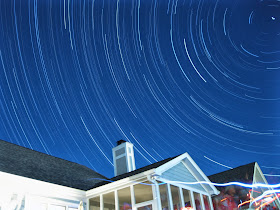This weekend I packed up all my gear and headed over to my friend John's house north of the city. It's not exactly dark skies, but there is a lot less light pollution from direct glare (but still can't escape the sky glow on the horizon). My goal was to photograph the moon, try to spot Andromeda through my scope, and then maybe check out some objects on the
September list or just show John some double stars that I'm already familiar with.
 |
| 232 images stacked in StarStaX, taken with Canon Powershot at ISO 800, 15 sec each |
 |
| DSLR at prime focus on Meade 285, 1/50 sec, ISO 200, stack of 20 images |
 |
| DSLR on fixed tripod, 196 subs, 44 darks, 42 bias, ISO 1600, f/5.6, 1.3 sec, 300mm |
I started by showing John how I set up my point and shoot to take star trail photos. We got this camera up and running first so that it could go the whole night while we were looking at other objects. Next, I went to the moon because it's such an easy target. We observed the moon, and then I tried to find the Andromeda Galaxy by star hopping. I still couldn't locate it with my scope! It must be too faint, and I must be too inexperienced.
After getting frustrated about Andromeda, I tried an easier target - I was able to find Albireo and showed John the color contrast between the two stars. Next, I tried to observe Beta Cephei, but I still couldn't resolve it into two different stars. I either had the wrong star, or my magnification (or resolution) just isn't high enough to split them.
I was, however, able to split Mizar and Alcor very easily. I put my camera back on the scope to take a few shots. I didn't notice it until I got the images onto my computer, but it looks like I actually got Mizar to split into its two subsequent stars (each of which are actually double stars themselves!). Tons of fun and quite the prolific night of observing!
 |
ISO 1600, 1/3 sec, Canon Rebel XT at prime focus on Meade 285
Mizar A/B have a separation of 14.4" (arcseconds) which I guess is about the limit of my setup |




No comments:
Post a Comment